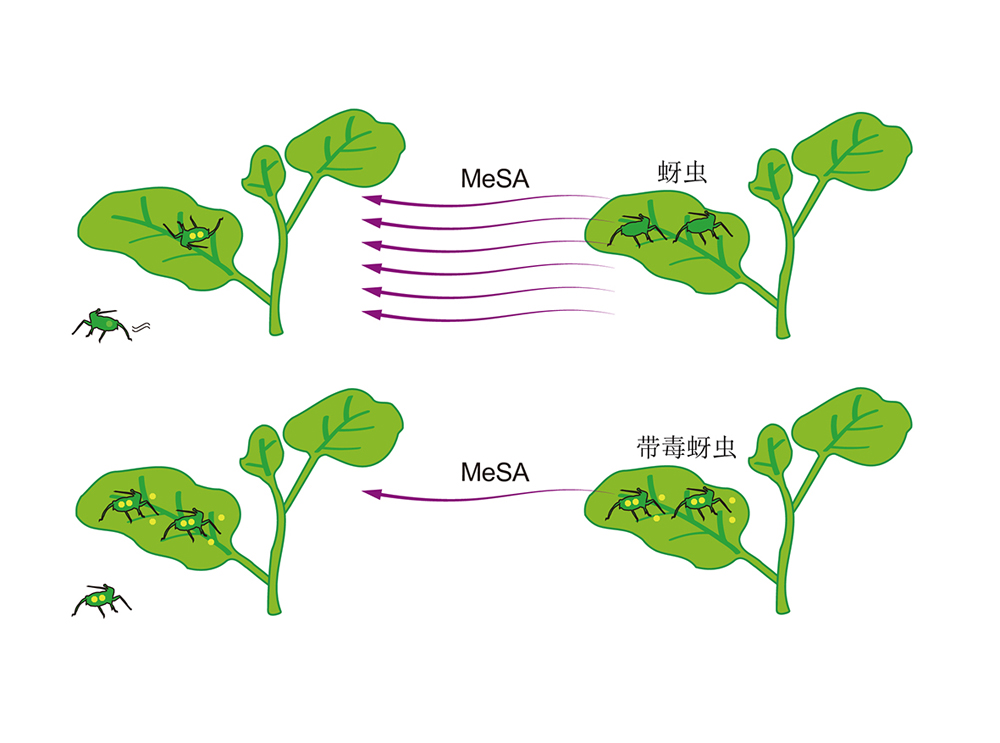

烽火狼烟: 水杨酸甲酯介导的植物间通讯和气传性免疫的机制解析
收稿日期: 2023-09-12
录用日期: 2023-09-13
网络出版日期: 2023-09-14
基金资助
科技部重点研发计划(2021YFA1301800);中国博士后科学基金(BX2021313);中国博士后科学基金(2022M713150)
Study Uncovers a New Signaling Circuit Mediating Airborne Defense of Plants Against Aphids and Viruses
Received date: 2023-09-12
Accepted date: 2023-09-13
Online published: 2023-09-14

袁民航 , 辛秀芳 . 烽火狼烟: 水杨酸甲酯介导的植物间通讯和气传性免疫的机制解析[J]. 植物学报, 2023 , 58(5) : 682 -686 . DOI: 10.11983/CBB23126

Key words: plant-plant communication; airborne defense; aphids; virus; MeSA; pest resistance; virus resistance
| [1] | Arimura GL, Ozawa R, Shimoda T, Nishioka T, Boland W, Takabayashi J (2000). Herbivory-induced volatiles elicit defence genes in lima bean leaves. Nature 406, 512-515. |
| [2] | Babikova Z, Gilbert L, Bruce TJA, Birkett M, Caulfield JC, Woodcock C, Pickett JA, Johnson D (2013). Underg-round signals carried through common mycelial networks warn neighbouring plants of aphid attack. Ecol Lett 16, 835-843. |
| [3] | Baldwin IT, Kessler A, Halitschke R (2002). Volatile sig-naling in plant-plant-herbivore interactions: what is real? Curr Opin Plant Biol 5, 351-354. |
| [4] | Casteel CL, Yang CL, Nanduri AC, De Jong HN, Whitham SA, Jander G (2014). The NIa-Pro protein of Turnip mosaic virus improves growth and reproduction of the aphid vector, Myzus persicae (green peach aphid). Plant J 77, 653-663. |
| [5] | Dudareva N, Raguso RA, Wang J, Ross JR, Pichersky E (1998). Floral scent production in Clarkia breweri. III. Enzy-matic synthesis and emission of benzenoid esters. Plant Physiol 116, 599-604. |
| [6] | Engelberth J, Alborn HT, Schmelz EA, Tumlinson JH (2004). Airborne signals prime plants against insect her-bivore attack. Proc Natl Acad Sci USA 101, 1781-1785. |
| [7] | Forouhar F, Yang Y, Kumar D, Chen Y, Fridman E, Park SW, Chiang Y, Acton TB, Montelione GT, Pichersky E, Klessig DF, Tong L (2005). Structural and biochemical studies identify tobacco SABP2 as a methyl salicylate esterase and implicate it in plant innate immunity. Proc Natl Acad Sci USA 102, 1773-1778. |
| [8] | Gong Q, Wang YJ, He LF, Huang F, Zhang DF, Wang Y, Wei X, Han M, Deng HT, Luo L, Cui F, Hong YG, Liu YL (2023). Molecular basis of methyl salicylate-mediated plant airborne defense. Nature https://www.nature.com/articles/-s41586-41023-06533-41583. |
| [9] | Haxim Y, Ismayil A, Jia Q, Wang Y, Zheng XY, Chen TY, Qian LC, Liu N, Wang YJ, Han SJ, Cheng JX, Qi YJ, Hong YG, Liu YL (2017). Autophagy functions as an antiviral mechanism against geminiviruses in plants. eLife 6, e23897. |
| [10] | Ismayil A, Yang M, Haxim Y, Wang YJ, Li JL, Han L, Wang Y, Zheng XY, Wei X, Nagalakshmi U, Hong YG, Hanley-Bowdoin L, Liu YL (2020). Cotton leaf curl Mul-tan virus betaC1 protein induces autophagy by disrupting the interaction of autophagy-related protein 3 with glyce-raldehyde-3-phosphate dehydrogenases. Plant Cell 32, 1124-1135. |
| [11] | Jia Q, Liu N, Xie K, Dai YW, Han SJ, Zhao XJ, Qian LC, Wang YJ, Zhao JP, Gorovits R, Xie DX, Hong YG, Liu YL (2016). CLCuMuB betaC1 subverts ubiquitination by interacting with NbSKP1s to enhance geminivirus infection in Nicotiana benthamiana. PLoS Pathog 12, e1005668. |
| [12] | Karban R, Yang LH, Edwards KF (2014). Volatile communication between plants that affects herbivory: a meta- analysis. Ecol Lett 17, 44-52. |
| [13] | Li R, Weldegergis BT, Li J, Jung C, Qu J, Sun YW, Qian HM, Tee C, Van Loon JJA, Dicke M, Chua NH, Liu SS, Ye J (2014). Virulence factors of geminivirus interact with MYC2 to subvert plant resistance and promote vector performance. Plant Cell 26, 4991-5008. |
| [14] | Loreto F, D'Auria S (2022). How do plants sense volatiles sent by other plants? Trends Plant Sci 27, 29-38. |
| [15] | Loreto F, Dicke M, Schnitzler JP, Turlings TCJ (2014). Plant volatiles and the environment. Plant Cell Environ 37, 1905-1908. |
| [16] | Mallinger RE, Hogg DB, Gratton C (2011). Methyl salicylate attracts natural enemies and reduces populations of soybean aphids (Hemiptera: Aphididae) in soybean agroe-cosystems. J Econ Entomol 104, 115-124. |
| [17] | Moreira X, Nell CS, Katsanis A, Rasmann S, Mooney KA (2018). Herbivore specificity and the chemical basis of plant-plant communication in Baccharis salicifolia (Asteraceae). New Phytol 220, 703-713. |
| [18] | Ninkovic V, Glinwood R, ünlü AG, Ganji S, Unelius CR (2021). Effects of methyl salicylate on host plant acceptance and feeding by the aphid Rhopalosiphum padi. Front Plant Sci 12, 710268. |
| [19] | Park SW, Kaimoyo E, Kumar D, Mosher S, Klessig DF (2007). Methyl salicylate is a critical mobile signal for plant systemic acquired resistance. Science 318, 113-116. |
| [20] | Staudt M, Jackson B, El-Aouni H, Buatois B, Lacroze JP, Poessel JL, Sauge MH (2010). Volatile organic compound emissions induced by the aphid Myzus persicae differ among resistant and susceptible peach cultivars and a wild relative. Tree Physiol 30, 1320-1334. |
| [21] | Wang YJ, Gong Q, Wu YY, Huang F, Ismayil A, Zhang DF, Li HG, Gu HQ, Ludman M, Fátyol K, Qi YJ, Yoshioka K, Hanley-Bowdoin L, Hong YG, Liu YL (2021). A calmodu-lin-binding transcription factor links calcium signaling to antiviral RNAi defense in plants. Cell Host Microbe 29, 1393-1406. |
| [22] | Yang M, Ismayil A, Jiang ZH, Wang Y, Zheng XY, Yan LM, Hong YG, Li DW, Liu YL (2022). A viral protein disrupts vacuolar acidification to facilitate virus infection in plants. EMBO J 41, e108713. |
| [23] | Zhao PZ, Yao XM, Cai CX, Li R, Du J, Sun YW, Wang MY, Zou Z, Wang QM, Kliebenstein DJ, Liu SS, Fang RX, Ye J (2019). Viruses mobilize plant immunity to deter nonvector insect herbivores. Sci Adv 5, eaav9801. |
/
| 〈 |
|
〉 |